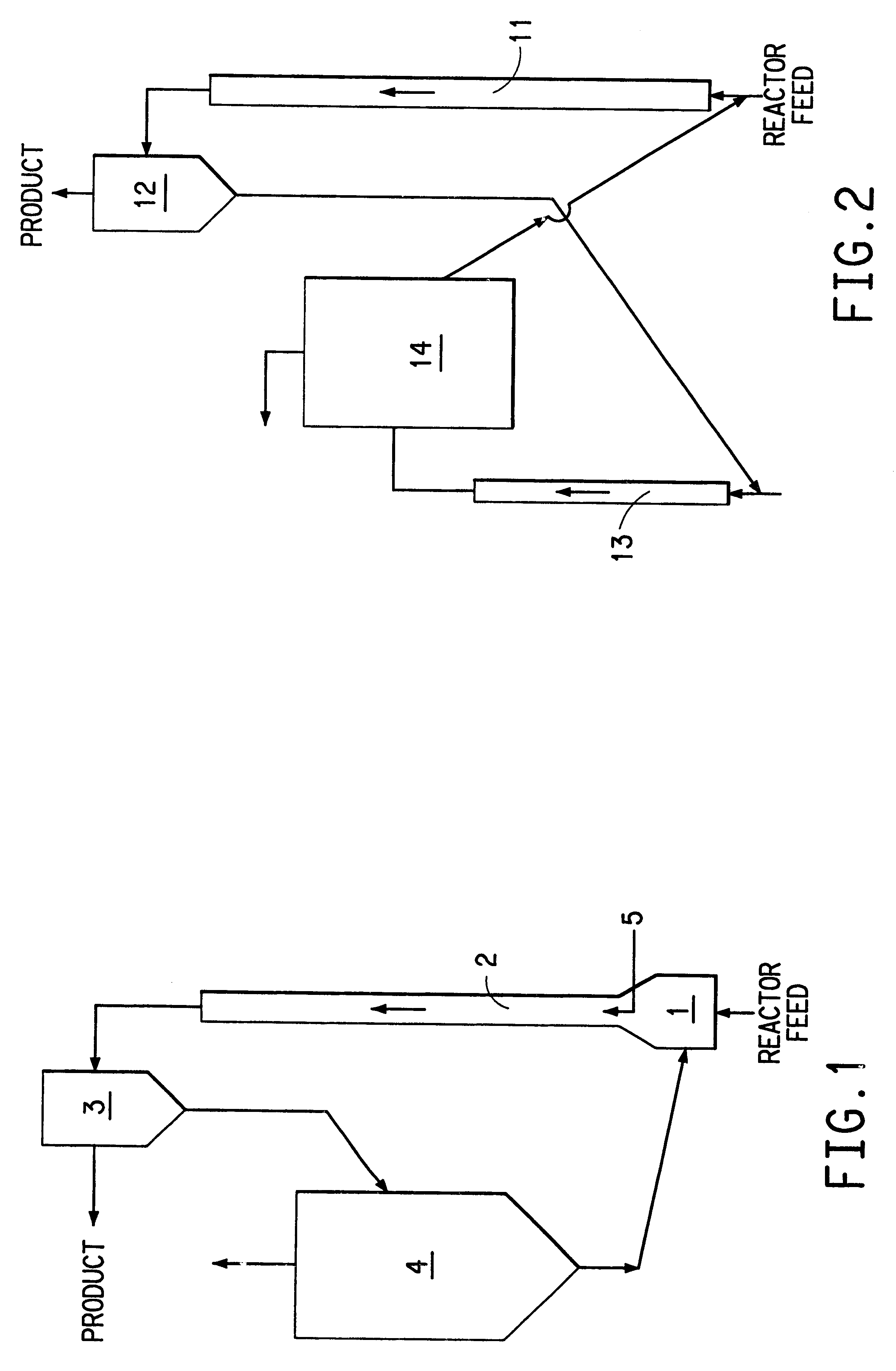Vapor phase oxidation of propylene to acrolein
- Summary
- Abstract
- Description
- Claims
- Application Information
AI Technical Summary
Benefits of technology
Problems solved by technology
Method used
Image
Examples
example 1
The attrition resistant solids used in the examples of this invention were prepared by substantially following the procedure in U.S. Pat. No. 4,677,084 and in particular the procedure found in Example 10. The starting solids used to make the attrition resistant solids were obtained following the procedure described in French patent application 97 02343 filed Feb. 27, 1997 in the name of ELF ATOCHEM S.A. and in particular by using multicomponent molybdate obtained according to example 5 of the French patent application. The starting solids prepared according to this French application corresponds to the formula: Mo.sub.12 Co.sub.3.5 Bi.sub.1.1 Fe.sub.0.8 W.sub.0.5 Si.sub.1.4 K.sub.0.05 O.sub.x, where x is the quanitity of oxygen bonded to the other elements and depends on their oxidation state. The procedure involved 60.9 grams of Co(NO.sub.3).sub.2.6H.sub.2 O being dissolved in 20 mL of distilled water. Also, 20.2 grams of Fe(NO.sub.3).sub.3.9H.sub.2 O were dissolved in 15 mL of dis...
example 2
In a manner similar to the procedure of Example 1, a series of four additional runs were performed in the recirculating solids reactor of the type shown in FIG. 1. In these runs propylene was converted to acrolein using commercially purchased bismuth molybdate multimetal oxide solids as the oxidant. The particular bismuth molybdate multimetal oxide solids employed had a history of being used commercially at DuPont's Beaumont facility for the manufacture of acrylonitrile and been rejuvenated after showing a decline in activity relative to the manufacture of acrylonitrile. The rejuvenation process involved addition of molybdenum to the spent catalyst. Quantitative elemental analysis of several batches of rejuvinated catalyst used in this example established that the empirical formula of the bismuth molybdate multimetal oxide corresponds to the formula; Ni.sub.2.1 Co.sub.3.5 Fe.sub.2.6 P.sub.0.43 Bi.sub.1.0 Mo.sub.9.3 Mn.sub.0.15 Cr.sub.0.09 Ba.sub.0.07 Zr.sub.0.0012 K.sub.0.07 O.sub.x...
example 3
In a manner analogous to the procedure of Example 1, a series of four additional runs were performed in the recirculating solids reactor of the type shown in FIG. 1. In these runs propylene was converted to acrolein using essentially the same bismuth molybdate multimetal oxide composition as was used in Example 1. The only difference was that the salt precursor after drying was not precalcined at 225.degree. C. in air but instead was directly milled to the desired particle size range and mixed with polysilicic acid solution. This slurry was then spray dried and the resulting solids were precalcined at 225.degree. C. in air and then calcined at 450.degree. C. for 9 hours in air to produce the attrition resistant solids. The process variables and test result data for these additional runs are presented in Table 5.
TABLE 5 PROCESS VARIABLES RESPONSES Fluid. C.sub.3 H.sub.6 / steam / N.sub.2 Gas Sol. Acrolein and Bed Feed Cont. Circ. Propylene Acrylic acid Test Temp Conc. Time Rate Conver. ...
PUM
| Property | Measurement | Unit |
|---|---|---|
| Length | aaaaa | aaaaa |
| Time | aaaaa | aaaaa |
| Time | aaaaa | aaaaa |
Abstract
Description
Claims
Application Information
 Login to View More
Login to View More - R&D
- Intellectual Property
- Life Sciences
- Materials
- Tech Scout
- Unparalleled Data Quality
- Higher Quality Content
- 60% Fewer Hallucinations
Browse by: Latest US Patents, China's latest patents, Technical Efficacy Thesaurus, Application Domain, Technology Topic, Popular Technical Reports.
© 2025 PatSnap. All rights reserved.Legal|Privacy policy|Modern Slavery Act Transparency Statement|Sitemap|About US| Contact US: help@patsnap.com

